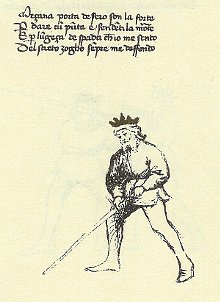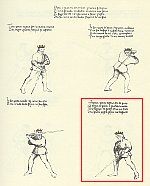

| Fiore dei Liberi: Flos Duellatorum, 1410 (Pisani-Dossi, F. Novati, Bergamo, 1902) |
| 4 spada longa - longsword |
| 4.1 poste (guards) |
| 4.1.4 meçana porta de fero, stabile1 (half iron gate) |
| Meçana porta de fero son la forte Per dare cum punte e fendenti la morte E per lungeça de spada che io me sento Del streto zogho sempre me deffendo |
| I am the strong middle iron gate For inflicting with a thrust and a deadly cleave And for me I feel that the sword length Of close play I will always defend myself |
Synopsis: It is evident that Fiore suggests this guard was a position of strength with a duel capability of both defense and offensive and indicating that this posta permits both cutting or cleaving strikes or thrusts. What is clear from the text is that the strike can be deployed without the need to move the feet. It suggests that this is more of a defensive position, and without the need to move the position of the feet (stabile), when whatever blow is delivered by the zugadore, it is met with frightening power in the form of either a cut (cleave) or thrust. Given the stationary footwork, the orientation of the body would not change and the movement of the sword would remain in the "middle" during the "beat" and the following fendente. Fiore mentions streto zogho in his text which further supports the notion that the footwork would remain stationary while deploying the "beat" and return with a strike when in close quarters or "clost play" (streto zogho). Secondly, given the relatively close proximity to the opponent, it is implied that this guard can effectively defend oneself as described above, or possibly deliver a thrust in relatively close range.
Application: The key point suggested by Liberi is that the meçana porta de fero or middle iron gate can deploy very strong parries against thrusts by quickly beating away the inbound thrust (time of the hand) and delivering a thrust in return (exchange of points). The successful deployment of this guard and the follow-on parry and thrust or strike requires mastery of both distance and timing which exemplifies Silver's combative principle of true time, specifically, time of the hand. All this of course while the feet remain stationary. Liberi suggests that this guard is best deployed in relative close quarters implying that the sword will remain an effective weapon in close range given the footwork. The guard is deployed with the right foot foreward and the right calf relatively vertically oriented, while the left foot trails behind resting on the ground on the ball of the foot only. This offers a degree of readiness should action be required in which movement of the feet is necessary. While maintaining the distance during the deployment of the beat and strike, the master would return to the middle iron gate thus ensuring he has adequate defenses in place at the conclusion of the strike.
| Fiore de' Liberi | 1410 | Mezza porta di ferro (Guard of the Middle Iron Door - armoured) |
| Fiore de' Liberi | 1410 | Denti di cinghiale (Guard of Boar's Tooth) |
| Hans Talhoffer | 1467 | (tafel 2) Twisted Cut and Low Guard |
| Hans Talhoffer | 1467 | (tafel 16) Guard of the Iron Door (Low guard) |
| Giacomo di Grassi | 1594 | The Low Ward |
| Giacomo di Grassi | 1594 | (13.3) Of the Defense of the Low Ward at Two Hand Sword |